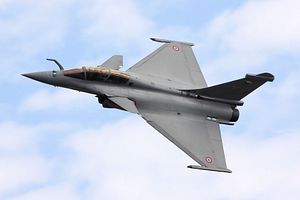On Friday, the government of India and French aircraft manufacturer Dassault Aviation signed an agreement valued at 7.87 billion euros for the sale of 36 Rafale multi-role fighters. The agreement was finalized through a government-to-government arrangement and was signed by French Defense Minister Jean-Yves Le Drian and Indian Defense Minister Manohar Parrikar. The twin-engine, multi-role fighters will fulfill an important shortfall in the Indian Air Force’s (IAF) arsenal, with New Delhi planning to use the fighters in part as “an airborne strategic delivery system” for nuclear weapons. Per Dassault’s timetable, the first Rafale fighter should arrive in India in 2019.
It’s been a long road for India and France getting to this point. The Dassault Rafale originally triumphed in 2012 as part of the competitive bidding process under the aegis of the now-defunct Medium Multi-Role Combat Aircraft (MMRCA) tender. Dassault’s competitors included Lockheed Martin, Boeing, the Eurofighter consortium, and Saab. As part of the MMRCA, Delhi was originally looking to fill the Indian Air Force’s requirement shortfall by purchasing 126 fighters.
Negotiations between Dassault and the Indian government continued for three years in the aftermath of the award of the MMRCA tender. Delhi’s reservations on the price for the 126 fighters were immediate but, in 2014, when Indian Prime Minister Narendra Modi came to office touting his ‘Make in India’ initiative, negotiations on the MMRCA appeared especially moribund over concerns that Delhi’s requirements for domestic assembly were asking too much of Dassault. The French manufacturer would not stand for India’s request to have over 100 of the 126 fighters constructed by Hindustan Aeronautics Limited (HAL) in India.
The government-to-government approach to the Rafale purchase was an unforeseen development when Indian Prime Minister Narendra Modi and French President Francois Hollande unveiled it during Modi’s trip to Europe early last year. Under the deal, India would buy 36 fighters in fly-away condition from the French. New Delhi, it appeared, had given up on the MMRCA approach and on domestic assembly. The MMRCA, which had come to be known as the “mother of all defense deals” in the defense press, was shortly thereafter declared dead by Indian Defense Minister Manohar Parrikar.
Though it initially appeared that the government-to-government approach would greatly simplify the conclusion of the deal, an agreement between the French and Indian sides has taken 18 months to date, with both sides bogged down over the per-unit price, so-called offset clauses requiring France to invest a certain portion of the revenue in Indian goods and services, and other matters.
Any effusiveness over the signing of the deal for the purchase of the Rafales is likely to be temporary for the Indian Air Force, which continues to face important structural and long-term problems. For instance, over the past decade, the IAF has seen its force strength diminish by several squadrons, partly due to crashes involving its older MiG-21 fighters and other aircraft, including some Sukhoi-30MKIs, Jaguars, and French Mirage-2000s. As my colleague Franz-Stefan Gady has written, the IAF is also struggling with a shortage of pilots.
Still, despite longer term problems, the conclusion of the Rafale saga is one of two important milestones for the IAF in 2016. The IAF also inducted its first indigenously developed Tejas Light Combat Aircraft (LCA) earlier this year. The single-engine light fighter is intended to replace India’s fleet of MiG-21s. (Still, if you thought the Rafale story was a tale of dreams delayed and deferred, the LCA project was initiated in 1983.)
































